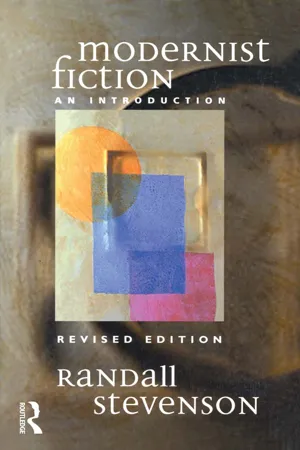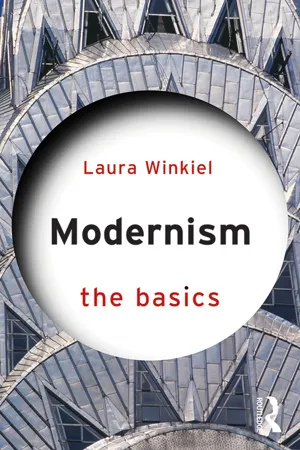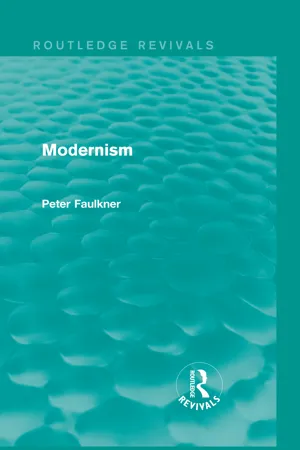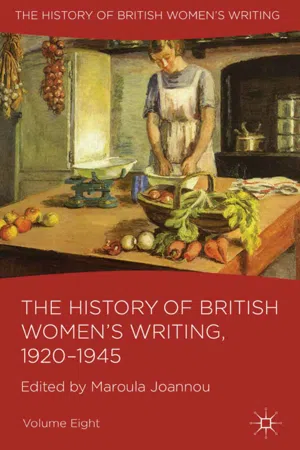Modernism
Modernism in literature refers to a movement that emerged in the late 19th and early 20th centuries, characterized by a break from traditional forms and a focus on individual experience, fragmentation, and experimentation with language and narrative structure. Modernist writers sought to capture the complexities and uncertainties of the modern world, often employing stream-of-consciousness, nonlinear storytelling, and a rejection of conventional plot and character development.
7 Key excerpts on "Modernism"
- eBook - ePub
- Anna Anselmo(Author)
- 2014(Publication Date)
- EDUCatt Università Cattolica(Publisher)
...Its historical and social background includes the emergence of the New Woman, the peak and downturn of the British Empire, unprecedented technological change, the rise of the new Labour Party, the appearance of factory-line mass production, war in Africa, Europe, and elsewhere. Modernism has therefore almost universally been considered a literature of not just change but crisis” [49]. 4. The Modernist Novel “Modernist writing,” Peter Childs writes, “arises at a certain time in history and at a particular point in literary history”. In terms of the novel, it is seen as a reaction to the hegemony of realism. Modernists did not criticize realism in aesthetic representation or the possibility of art as mimesis, but the realist fiction which, during the eighteenth and nineteenth centuries, went under the name of realism. Classic realism flowered in the nineteenth century and can be identified as possessing certain characterizing features: reliable narrators and representative characters immersed in recognizable settings and in a recognizable social system. “Classic realism,” Catherine Belsey writes, “presents individuals whose traits of character, understood as essential and predominantly given, constrain the choices they make, and whose potential for development depends on what is given. Human nature is thus seen as a system of character-differences existing in the world, but one which nonetheless permits the reader to share the hopes and fears of a wide range of kinds of characters...
- eBook - ePub
Modernist Fiction
An Introduction
- R.W. Stevenson(Author)
- 2014(Publication Date)
- Routledge(Publisher)
...Modernism is a critical construct – a recognition, some years after writers completed the work involved, of substantial similarity or even a collective identity in the initiatives they took and the styles and concerns they made a priority. This, however, does not make less viable the idea of Modernism or of its coherence as a movement. As the present study will show, developments individual authors made independently from each other are nevertheless clearly comparable, and often related to one another more or less logically and progressively, one change of style following incrementally from another throughout the early decades of the century. Yet modernist authors’ relative independence from each other does raise one obvious question about their work. If mutual association or influence cannot much account for manifold similarities throughout this phase of contemporary writing, what can? One answer, really as obvious as the question, has already been offered by Alan Friedman’s remarks, quoted in the Preface. The originality of modernist fiction, for Friedman, is owed to the originality of ‘the modern experience’ itself, to ‘causes’ in its philosophy, psychology, science, society, economics and politics. Along with so much contemporary art, modernist fiction changed radically in structure and style because the world it envisaged changed radically at the time, as indeed did means of envisaging it. Analogous innovations in so many contemporary art forms may have arisen not from mutual influence – Joyce did not restructure his work only because contemporary painters had done so, nor vice versa – but from common apprehension of the shifting nature of life, and of methods of perceiving it, in the early twentieth century...
- eBook - ePub
- Laura Winkiel(Author)
- 2017(Publication Date)
- Routledge(Publisher)
...For instance, we turn to Picasso’s painting in order to understand important formal qualities of modernist literature and painting, especially in terms of how they differ from realist representation. Realism is a mode of literary and artistic representation that aims to convey its subject matter in a faithful or true-to-life manner. (Although we are here distinguishing realism from Modernism in order to define modernist formal qualities, the two terms, “Modernism” and “realism,” are not mutually exclusive, as we will discuss in Chapter 4.) Then we will consider our second point: why it is no longer sufficient to think of Modernism as strictly the domain of experimental art by white European men, with perhaps a sprinkling of experimental women artists, such as Virginia Woolf or Gertrude Stein, thrown into the mix. For those readers whose interest lies primarily with the canon of modernist authors, you are invited to consult the “further reading” section at the end of this chapter for introductions to Modernism that concentrate on difficult “high modernist” texts and paintings. A strict emphasis on the canon, however, curtails a fuller understanding of how Modernism took place in many locations and in many forms. It misses the forest for a few difficult trees. Modernism: The Basics is different from other introductions to Modernism because it includes the most recent developments in the study of Modernism, what are often called “the new Modernisms.” In short, our emphasis on “the new Modernisms” reflects the growing awareness that Modernism arose around much of the world, often through social movements (such as women’s, labor and national independence movements), and during an ongoing period of great technological, economic and political change. New media – print, sound, visual and communication technologies – also transformed how artists and writers saw the possibilities of their art...
- eBook - ePub
- Jacob Stratman(Author)
- 2016(Publication Date)
- Research & Education Association(Publisher)
...On one hand, literature maintained a didactic nature in which stories, poems, and even novels were written to teach a particular truth, or in the least, to be grounded in a central truth. Second, literature entertained its readers with exciting plots, familiar characters, domestic and exotic settings, and elevated language in very linear and traditional forms. This was the artist’s job before literary Modernism began asking questions. Modernists found this description of literature too imitative and overly simplistic, partly because the nature of truth, according to modernists, was much more complex, detached, and multivocal than the Puritans and their descendants taught. Modernist writers found much of what the previous generations taught them about truth as suspect and simplistic, including social concerns, religion, politics, and art. According to Archibald MacLeish’s modernist poem, “Ars Poetica,” “A poem should not mean, / But be” (Hunter 1996, 254). In one sense, this passage could be the slogan for literary Modernism. These writers resisted any moral or didactic leanings that could distract the reader from appreciating the aesthetic beauty of the poem itself. So poetry at this time dedicated itself to itself and neglected much of life outside of the poem. Good literature, according to the modernists, remained slightly beyond the grasp of general readers and became complex and abstract systems of art that preoccupied itself with its own meaning. What is important to note about literary Modernism is that not all of its literature sang the praises of the modern world. Although the literature’s content and form break with tradition in many ways, some writers use these new forms and taboo issues actually to attack modernity, exploring the growing tension between freedom and loss. In fact, some could assert that the modern era is one of fragments...
- eBook - ePub
- Peter Faulkner(Author)
- 2013(Publication Date)
- Routledge(Publisher)
...2 The era of Modernism: 1910–1930 Socially the period was one of widespread turmoil and suffering, including the 1914–18 war and the beginning of the economic depression. Yet culturally it was a great creative period, which produced such works as Eliot’s The Waste Land, Pound’s Hugh Selwyn Mauberley, Joyce’s Ulysses, Lawrence’s Women in Love, Virginia Woolf’s To the Lighthouse, and Yeats’ The Tower, to say nothing of the contemporary work of Rilke, Blok, Mayakovsky, Pasternak, Machado, Apollinaire, Ungaretti, Alberti, Mann, Proust, Kafka, and Svevo. And this is in literature alone. The challenge to the artist is always to combine openness to experience with formal control, and the art of this troubled period often thrived on the challenge. The discussion in this section is at first general and then specific, focusing in the later parts on the critical ideas of two leading modernists, Eliot and Virginia Woolf, and ending with two major modernist works, Pound’s Mauberley and Joyce’s Ulysses, and with a general account of D. H. Lawrence. General considerations Any ascription of dates to cultural movements is bound to be arbitrary, but there can be little doubt that the two decades 1910–30 constitute an intelligible unity from the point of view of the present discussion. (Obviously historians of politics, war or economics will see the century in a different shape – but that kind of plural vision is one of the central recognitions of Modernism itself.) There can be valid disagreement about the extent of the interaction between culture and society, but it is evident that modernist art is very much aware of the state of the world around it. Thus many kinds of facts about the early twentieth century are relevant. In general what was happening can be seen as a breaking-up (more or less violent in different countries and areas of activity) of the nineteenth-century consensus...
- eBook - ePub
- M. Joannou(Author)
- 2016(Publication Date)
- Palgrave Macmillan(Publisher)
...This can appear profoundly at odds with the secular sensibility of the twenty-first century, as well as the recognition that Modernism has been tarnished by its history of association with discredited or exclusionary aesthetics and politics. As Peter Childs puts it, ‘Modernism has predominantly been represented in white, male, heterosexist, Euro-American middle class terms, and any of the recent challenges to each of these aspects introduces another one of a plurality of Modernisms’. 9 In Bad Modernisms (2006) Douglas Mao and Rebecca Walkowitz summarized critical developments thus: Some contemporary scholars have even chosen to apply ‘modernist’ yet more globally – to say, all writing published in the first half of the twentieth century – thereby transforming the term from an evaluative and stylistic designation to a neutral and temporal one, and thus economically countering the implication that a few experimental works were somehow the only ones authentically representative of their age (in the familiar sequence Romantic-Victorian-Modernist-Postmodernist). 10 The most inclusive understanding of Modernism contends that this is primarily ‘an engagement with the intellectual problems of modernity’ and that ‘the formal properties of literature are only one means to that end’. 11 Moreover as Peter Brooker, Andrzej Gasiorek, Deborah Longworth, and Andrew Thacker explain, critics no longer assume the aesthetic to be the principle issue of concern in discussions of Modernism and its legacies: ‘No less important is the need to grasp where Modernism(s) emerged; how they developed; by what means they were produced, disseminated and publicized; in what relationship they stood to other artistic and cultural forms, which might be (or might in the past have been) regarded as non-modernist.’ 12 The discussion of Modernism in this volume reflects the well-established...
- eBook - ePub
Reading Between the Lines
A Christian Guide to Literature
- Gene Edward Veith Jr.(Author)
- 2013(Publication Date)
- Crossway(Publisher)
...Modernist writers such as T. E. Hulme, Allen Tate, Robert Penn Warren, W. H. Auden, Evelyn Waugh, and Flannery O’Connor embraced Christianity (often of a Roman Catholic or high church Anglican variety). These writers still depicted the external world as bleak and empty—according to Christianity, the modern world without Christ is bleak and empty. They still experimented with bold, original, idiosyncratic styles Christianity by no means hindered their literary creativity. These writ ers were inspired all the more to devise unique and distinctive styles to express their convictions to a world oblivious to the meaning that they themselves found in Christ. POSTModernism Literature is always in a state of change, so that what once seemed dar ing and experimental seems quaint and old fashioned only a few years later. Modernism in its various modes dominated the first half of the twentieth century and was practiced by writers who have made their mark but are no longer living. Ironically, Modernism, once the quin tessence of radicalism, now does not seem so modern. Contemporary writers, artists, and thinkers are presently turning against Modernism. A new cultural movement is in the air. “PostModernism” promises to be as varied and difficult to define as Modernism. Like all secular movements, postModernism holds both peril and promise for Christians. Already it has enlivened architecture and moved literary criticism, of all things, to a central place in the intel lectual establishment. Disdaining elitism, the Postmodern movement reaches out to the popular culture. PostModernism refuses to take itself too seriously, which is healthy in any literary movement; the problem is that it sometimes fails to take anything seriously. Acutely aware of the decline of religion, Matthew Arnold offered literature as a substitute...






